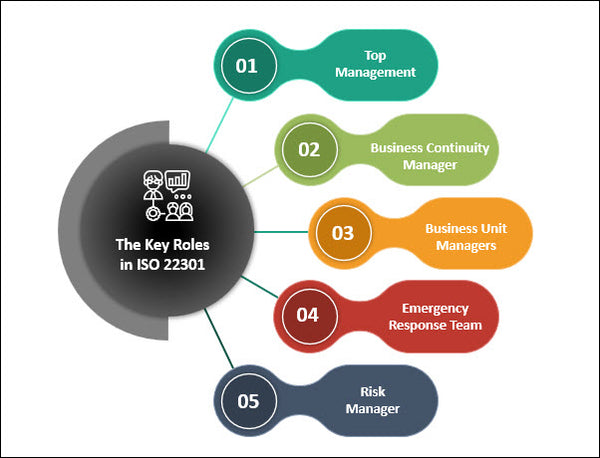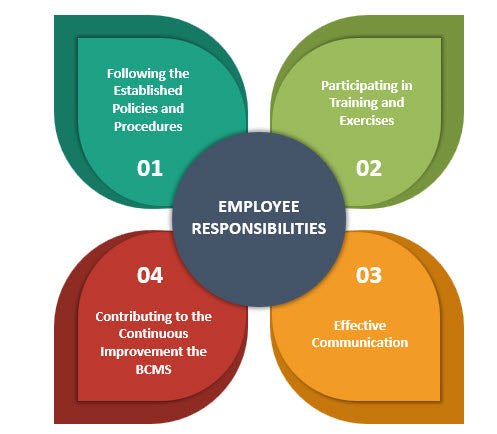ISO 22301 Roles and Responsibilities in BCMS
ISO 22301, the international standard for business continuity management systems (BCMS), provides a framework for organizations to effectively plan, respond, and recover from disruptive incidents. A key aspect of implementing ISO 22301 is clearly defining roles and responsibilities within the BCMS. This ensures that all individuals understand their duties and can contribute to the organization's resilience. In this blog, we will delve into the importance of roles and responsibilities in BCMS and guide you on establishing and assigning them within your organization according to ISO 22301 requirements.

Understanding ISO 22301 and BCMS
To effectively establish and assign roles and responsibilities within your organization's BCMS, it is crucial to have a solid understanding of ISO 22301 and the principles of business continuity management systems. ISO 22301 is designed to help organizations identify potential threats, assess their impact, and develop mitigation strategies.
The standard emphasizes the importance of a proactive approach to business continuity, focusing on prevention rather than merely responding to incidents. It provides a systematic framework for organizations to identify critical processes, determine recovery objectives, and establish strategies to ensure continuity.
By implementing ISO 22301, organizations can enhance their overall resilience and minimize the impact of disruptions. It helps establish clear roles and responsibilities for all individuals involved in the BCMS, ensuring a coordinated and effective response to incidents.
In the next section, we will explore the key elements of ISO 22301 and how they contribute to establishing roles and responsibilities within your organization's BCMS. Stay tuned to learn more!
The Key Roles in ISO 22301
In ISO 22301, several key roles are crucial in successfully implementing and operating a Business Continuity Management System (BCMS). These roles ensure that the necessary actions are taken to protect the organization from disruptions and preserve its ability to function.
1. Top Management: The leadership team drives the BCMS implementation and ensures its effectiveness. They provide the necessary resources, commitment, and support to establish a culture of resilience within the organization.
2. Business Continuity Manager: This individual oversees the development, implementation, and maintenance of the BCMS. They coordinate with all departments to ensure that plans are in place, monitored, and tested regularly.
3. Business Unit Managers: Each department has a Business Unit Manager responsible for implementing and maintaining business continuity plans within their respective areas. They work closely with the Business Continuity Manager to ensure alignment with overall organizational objectives.
4. Emergency Response Team: This team is responsible for immediate response and actions during an incident, such as evacuation, communication, and damage assessment. They are trained to handle emergencies and ensure the safety of employees, customers, and assets.
5. Risk Manager: This role is responsible for assessing risk, identifying potential threats, and implementing risk management strategies. They work closely with other roles to develop effective business continuity strategies.
In collaboration with other stakeholders, these key roles provide a clear framework for establishing and implementing roles and responsibilities within your organization's BCMS. Understanding their functions and responsibilities is essential to ensure a coordinated and effective response to incidents, minimizing the impact on your organization's operations.
Responsibilities of the Business Continuity Management

The Business Continuity Management (BCM) team implements and maintains ISO 22301. Their role is essential in ensuring the effectiveness and resilience of the Business Continuity Management System (BCMS).
1. Developing and Implementing Policies and Procedures: The BCM team is responsible for establishing and documenting policies and procedures that outline the organization's approach to business continuity. These policies guide all employees and stakeholders on their responsibilities during incidents and disruptions.
2. Conducting Risk Assessments: The BCM team conducts regular risk assessments to identify potential threats and vulnerabilities that could affect the organization's ability to operate. They assess the impact and likelihood of these risks and develop mitigation strategies to minimize their impact.
3. Developing and Maintaining Business Continuity Plans: The BCM team works with business unit managers to develop and maintain comprehensive business continuity plans for each department or function. These plans outline specific actions and procedures to be followed during a disruption, ensuring a coordinated and efficient response.
4. Coordinating Training and Awareness Programs: The BCM team ensures all employees are trained on their roles and responsibilities during incidents and disruptions. They conduct regular awareness programs and exercises to test the effectiveness of the BCMS and enhance the organization's response capabilities.
5. Continuously Monitoring and Evaluating the BCMS: The BCM team is responsible for monitoring and evaluating the effectiveness of the BCMS. They regularly review and update the plans and procedures to address emerging threats or changes in the organization's operations.
By fulfilling these responsibilities, the BCM team ensures the organization's readiness to respond to incidents and disruptions. They play a crucial role in maintaining the organization's resilience and ensuring the continuity of its operations.
The Importance of Employee Responsibilities
While the BCM team holds significant responsibilities in implementing and maintaining ISO 22301, it is equally important for all employees to understand and fulfil their roles and responsibilities in the Business Continuity Management System (BCMS).
Employees are the front-line responders during incidents and disruptions, and their actions can significantly impact the effectiveness and resilience of the BCMS. All employees must know their responsibilities and be prepared to act swiftly and appropriately.
Specific employee responsibilities may include:
1. Following the Established Policies and Procedures: Employees should familiarize themselves with the organization's business continuity policies and procedures and ensure they understand and adhere to them. This includes reporting incidents and disruptions promptly, following prescribed incident response protocols and maintaining accurate records.
2. Participating in Training and Exercises: Employees should actively participate in training programs and exercises conducted by the BCM team. This helps them to understand the BCMS, familiarize themselves with their specific roles and responsibilities, and practice their response capabilities in simulated scenarios.
3. Effective Communication: Employees should promptly and accurately communicate incidents and disruptions to the appropriate channels outlined in the BCMS. They should also ensure effective communication with their team members and management during such situations, providing updates and following established communication protocols.
4. Contributing to the Continuous Improvement the BCMS: Employees should provide feedback and suggestions for improving the BCMS based on their experiences and observations. This can help identify gaps or areas for enhancement, ensuring the BCMS remains current and effective.
By understanding and fulfilling their responsibilities, employees become valuable contributors to the resilience and continuity of the organization's operations. The BCM team and employees working harmoniously ensure a robust BCMS that can effectively respond to any incident or disruption.
Conclusion
In conclusion, the success of a Business Continuity Management System (BCMS) is not solely reliant on the efforts of the BCM team. Every employee has a vital role in ensuring the effectiveness and resilience of the BCMS. By following established policies and procedures, participating in training and exercises, communicating effectively, and providing feedback for improvement, employees contribute significantly to the continuity of operations.
The BCM team and employees working harmoniously create a robust BCMS that can effectively respond to any incident or disruption. All employees must be prepared and proactive in their roles, as their actions during incidents can significantly impact the overall effectiveness of the BCMS.
By understanding and fulfilling their responsibilities, employees become valuable contributors to the organization's resilience and continuity, ensuring that operations can resume smoothly and efficiently in

